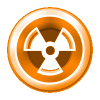Category:Editing C-9 Effects
NOTE: Much of information on this page is from around 1999. Some may be outdated, and some may be incorrect -- this page exists to get you started with the Level Editing and may not currently cover some of the additional features available in Mapster32.
C-9 Canisters (Visible)
C-9 is what creates the majority of choreographed explosions in Duke,Nukem 3D. To create an explosive can, simply place a sprite where you want the can to be. Change it to either the C-9 sprite (#1247), the OOZFILTER sprite (#1079), or the exploding barrel sprite (#1238). If you want to place explosive underwater mines, place the BOUNCEMINE sprite (#940). If you own version 1.4 or 1.5 of Duke Nukem 3D, you can use the GUNPOWDERBARREL (#4360) as well.
Switch Activated Explosions
This effect allows you to choreograph explosions and set them off via a switch.
- STEP 1: Place a switch sprite somewhere in your level. This will be where you set off the explosion from. Give the switch sprite a unique lotag value.
- STEP 2: Place one Masterswitch sprite in *every* sector that you want an explosion to take place in. Give every single Masterswitch sprite the same lotag value that you gave the switch. If you want to create a delay between flipping the switch and the first explosion, give the Masterswitch a hitag value of the delay you wish to have.
- STEP 3: Place C-9 sprites (#1247) everywhere you want an explosion to take place. You can raise the sprites to where you want, creating some nicely choreographed explosions.
- NOTE 1: Placing a large number of C-9 sprites can cause your computer to slow drastically if you are running on a slower processor.
- STEP 4: Shrink each C-9 sprite as far as you can width wise. This can be done by using the [5]+[4] key combination on the *numberpad*. When the sprites shrink no farther, you know that you are as small as you can get.
- STEP 5: Give every C-9 sprite a hitag value equal to the lotag value that you gave the switch in step 1.
- STEP 6: Now give each C-9 sprite any lotag value that you want. The lotag value for each C-9 sprite is the delay that the C-9 will wait before exploding.
- NOTE 2: A lotag value of 0 on the C-9 sprites will cause these sprites to *not* explode. Make sure that the lotag value is greater than 0.
- NOTE 3: A lotag value of 96 is roughly one second. Experiment to find out what is best for your situation.
Touchplate Activated Explosions
To create Touchplate activated explosions, follow the exact same procedure in the above section (Switch Activated Explosions). The only change here is that you replace the switch sprite with a Touchplate sprite.
Cracked Walls
This effect is what allows the player to launch some sort of explosive at a crack in a wall, generally forming a hole in the wall in which the player can walk through.
- STEP 1: Create your "hole" sectors where you want the hole to be. They all should be valid player space. You can use as many sectors as you want, but the more sectors you use, the more work you will have to put into this construction. Make this hole look like you want it to look *after* the explosion has occurred. You can tilt the floor and ceiling as much as you want as well.
- NOTE 1: The floor and ceiling should fit perfectly when lowered together (i.e. - the slope amount for each should be the *exact* same). This is not required, but it certainly makes the effect look better.
- STEP 2: Place a crack sprite (#546, #547, #548, or #549) on the wall in front of the hole sectors. Give the crack sprite a unique hitag value.
- NOTE 2: It is recommended to make the crack sprite slightly transparent. This can be done by pressing the [T] key on the sprite while in 3D mode.
- STEP 3: Place one sector effector sprite in each hole sector. Give each sprite the same hitag value that you gave the crack sprite. Now give each a lotag value of 13.
- STEP 4: Place C-9 sprites throughout your hole if you want to have explosions when the hole is blown open. If you do not wish to have any explosions take place, skip this step. Shrink each C-9 sprite as far as you can width wise (with the [4]+[5] key combination on the *numberpad*). When the sprites shrink no farther, you know that you are as small as you can get. Give each C-9 sprite the same hitag value that you gave the crack sprite. Now give each C-9 sprite a lotag value equal to the delay that you want the C-9 to have before exploding.
- STEP 5: You are now completely finished! Take a look at the tutorial map if you do not fully understand.
Fixing The ‘Texture Problem’
Making the Ceiling Blow Up (And Enemies Fall From the Sky!)
This category currently contains no pages or media.
